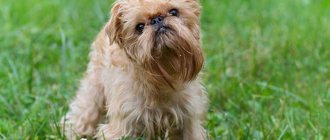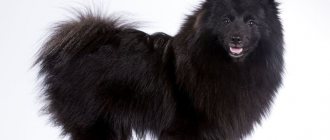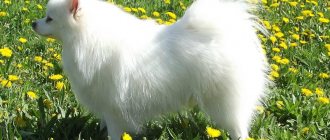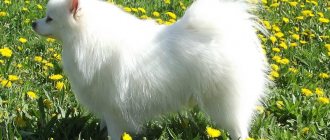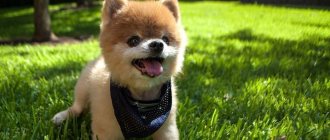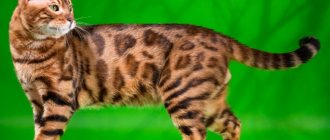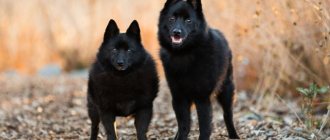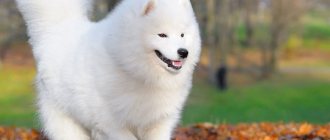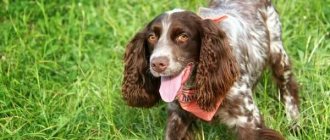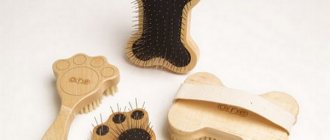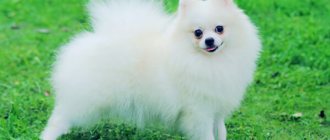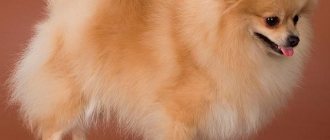This is the name given to all the varieties of dogs that the Spitz breed includes because they have many common features. These include: protruding thick fur, a tail curled up, pointed ears, a charming “smiling” face with shiny beady eyes.
The breed is extremely popular due to the miniature size of the dogs and their toy appearance. The most common types of pets are dwarf and Pomeranian. In some countries they are considered an independent variety, and in some they are classified as a dwarf breed of German Spitz.
Origin of the breed and purpose
The roots of the Spitz breed go back to the distant past, to the times of Ancient Greece and Rome. The popularity of animals peaked in the countries of Northern Europe during the Middle Ages. Although Germany is considered to be the homeland of the Spitz, breeding work was carried out:
- In Holland, Denmark, Finland.
- In Siberia, they were aimed at breeding the Spitz-shaped husky.
- Initially, breeders sought to create watchdogs called Gross Spitz dogs to protect houses, courtyards, as well as barges and ships.
- Dogs were used during hunting.
- Decorative purposes came to animals much later. By the 19th century, it had become fashionable to take classic, breed-standard miniature Spitz dogs into homes for decorative purposes.
- The process of populating noble houses with Spitz dogs proceeded quickly. The breed has a new purpose, and with it, a name (“ladies’ dogs”).
This social phenomenon in Russia was noticed by the Russian writer Anton Pavlovich Chekhov, who called his popular story “The Lady with the Dog.” The artwork has become a symbol of the purpose of the Spitz. History shows the gradual path of Spitz dogs from working dogs with a powerful physique and well-developed muscles to toy pets living on the sofas of high society living rooms. In such a situation, these cute animals continued to serve as guards. They have excellent hearing and a keen sense of smell. These properties help them smell a stranger from afar, informing their owners about this with a loud bark.
Historical fact! The trendsetter for Spitz was the English Queen Victoria, who never parted with her pet, Spitz Marco. The love for the miniature breed among people was boundless. Painters depicted them on artistic canvases, writers and poets - on the pages of fine literature.
New era
But after the victory in World War II, soldiers began to bring Spitz dogs from Germany as trophies. Few could afford the luxury of keeping a decorative dog, but already in the 1950s, dog breeding gradually began to develop.
In the early 1990s, the popularity of Spitz began to increase, and promising manufacturers were imported from leading foreign nurseries. In 1996, the National Spitz Fanciers Club appeared. Currently, Russian dogs not only seriously compete with those from foreign kennels, but also often surpass them.
Advantages and disadvantages of the breed
Spitz have pros and cons of the breed, being no exception. Its advantages include:
- The animal eats little and is unpretentious to food.
- Does not freeze in severe frosts.
- The cheerful and energetic disposition of the Spitz goes well with the active lifestyle of the owner.
- Gets along easily with household members and other pets.
- Doesn't let you get bored.
- It is everyone's pet.
The breed has serious disadvantages. These include:
- As a result of selection, a small Spitz (like a bear cub), whose muzzle is made shorter and shorter by breeders, acquires respiratory pathology due to deformation of the trachea and nasopharynx.
- The excitement of the game can ruin things.
- An incredibly loud animal.
On a note! The dog is extremely sociable, so it is difficult to tolerate long separation from household members. It is undesirable to leave him at home alone for a long time, as he begins to feel sad.
Color
Thanks to its upright coat, the Spitz appears very fluffy, and its interesting color makes it incredibly attractive and unusual. By the way, the true color of the fur appears only after six months of the dog’s life. The main colors are as follows:
- White;
- Orange;
- Cream;
- Sable;
- Black;
- Brown;
- Blue.
Often the shades are mixed - unusual, unique colors are obtained, so each Spitz has an individual color with spots or streaks.
Spitz varieties
Spitz dogs come in several varieties, differing in size. At the same time, the types of Spitz differ greatly in breed characteristics. These include:
- German;
- Pomeranians;
- Japanese;
- American Eskimos;
- Italian;
- Eurasian;
- Greenlandic;
- Karelian-Finnish Laika;
- Karelian bear dog.
All varieties of this dog breed are called Spitz:
- Most of them come from the North (Siberia, the Arctic). There they were used to protect homes and transport.
- It is known from references that certain species came from Ancient Greece and Egypt.
- In the 15th century, the Miniature Spitz was bred in Pomerania.
- The Dwarf Spitzhund was created in 1450. He weighed only 9 kg. However, selective reduction in Spitz size continued.
Bred in England in the 18th century, the dwarf Spitz gained enormous popularity.
From the history of the breed! Queen Victoria of England participated in the process of selection work to develop the dwarf breed. With her light hand, the miniature Pomeranian Spitzhund acquired the image of a lap dog.
The difference between the species is the features of body proportions. The breed has almost the same body length and height. Types and names vary depending on the area of origin. In Russia, all varieties are called German, the difference is only in size. It is customary to distinguish subgroups.
| Group of animals | Large (Wolfspitz) | Medium (Middle Spitz). The group includes: Finnish, American, Eskimo, Japanese, Spitz | Small (Kleinspitz) | Pomeranian dwarf. It has three subtypes: “Bebby doll”; "Teddy Bear"; "Fox" |
| Size at withers (cm) | 50 | 40 | 29 | 10 |
The hallmarks of all dog varieties are a short neck and vertically placed paws. They also have many common features:
- A tail curled into a donut, covered with long hair.
- There is a long wool collar on the chest.
- Velvety short hair on the head.
- Black beaded eyes, slightly slanted almond cut.
- The small black nose has a rounded lobe.
- Small, triangular-shaped ears that are located almost side by side on the top of the head.
- A fox-like muzzle is located on the large skull, especially in miniature varieties of dogs.
- Rich color palette.
- A two-layer fluffy, warm coat with a long top layer and a thick undercoat.
- Straight back axis.
- The chest is different in depth.
- Legs are strong.
- Square body format.
With a large number of common features of the breed, each type of animal has its own characteristics.
German Spitz
This type is related to one of the first to begin recording time from turf dogs. The Spitz is considered a relative of the Saino Spitz, which is one of the oldest European breeds. There are several varieties of it.
| Wolfspitz (Keeshond) | Gross Spitz (Big) | Mittel Spitz (Medium) | Klein Spitz (Small) |
| A large animal, height at the withers is 55 cm. In appearance it resembles a wolf, its distant ancestor. She is mostly black in color. On the face with darkening. Used to protect the family. The dog is friendly and welcoming, can play with children and take care of them and pets. | Height at the withers ranges from 42 to 51 cm. It comes in brown, white and black. The dog is good-natured and very attached to the owner, his family and home. He is ready to protect them from danger. Has high intelligence. They use it as a companion and protector. | Height ranges from 30 to 38 cm. This is a dog that is an intermediate link between large and small Spitz representatives. Acts as a compromise when choosing if the family cannot come to a common decision on choosing a decorative friend or a huge watchman. | Height is 23-29 cm. Regardless of the dog, it performs the functions intended for it by its breed, a guard, and reacts with lightning speed to the danger that arises, filling the house with a piercing loud bark. He adores his owners, being their devoted and faithful friend. Excellent health, as well as a complete absence of hysteria in his character, are his big advantages. |
Each variety perfectly performs the duties of companions and guards. Possessing good health and good immunity, German Spitz delight their owners with their presence for 12-16 years .
Pomeranian Spitz
This variety has German roots, as it was bred in Pomerania (Germany). Pomeranians reached their highest point of adoration in England in the 19th century. Description of the Pomeranian Spitz is a miniature dog, having only 18-22 cm at the withers and 1.5-3.5 kg in weight . The appearance of oranges is charming and funny:
- They resemble fluffy balls.
- The kids have a friendly, playful character.
- Immensely energetic, always ready to play.
- The presence of high intelligence and quick wits makes them obedient to training.
- Pomeranians cannot imagine their life without the constant attention of their owner and are very attached to him.
- This decorative domestic dog belongs to the category of fidgety. She cannot sit in her arms for a long time, she constantly frolics and is on the move.
- The dog reacts very sharply to strangers. An attempt to pet him may result in loud barking, as well as a desire to bite the stranger.
The Pomeranian is a charming, funny, kind animal with the voice of a siren, devoted, faithful, and reliable in protecting the home. Its biological life span ranges from 12 to 15 years.
Japanese Spitz
The breed was first bred in Japan in the 20-3 years of the last century. Spitz originated from Samoyed Laikas as a result of their crossing with the German Spitz. The height of the animals is 38-40 cm with small sizes. Dogs have a dense and stocky build. A striking feature of the Japanese Spitz is their thick snow-white coat. The variety is characterized by cheerfulness and good nature. Spitz are great admirers of children; he plays with the kids as much as he likes with great pleasure. The dog lives from 10 to 16 years.
Note! In addition to the brilliant appearance produced by the snow-white coat, the Japanese Spitz has another very valuable quality. He barks extremely rarely. His voice does not irritate the ears of his owners.
Finnish Spitz
The breed was bred in Finland in the 19th century, at the time of its widespread distribution:
- Individuals of this species are quite large. They reach 40-50 cm. Males are somewhat larger. Their weight can be more than 10 kg .
- The character of the representatives of the variety is independent, energetic, active.
- The dogs are good-natured, attached to their owner, but they are not too diligent and loud-voiced.
Finnish Spitz are used for hunting birds and small animals. The life expectancy of dogs is from 12 to 14 years.
American Eskimo Spitz
The breed was bred in America. She is characterized by an innate distrust of strangers. The dogs are well trained and correctly carry out the owner’s commands. Dogs are man's faithful friends and have a cheerful and playful disposition. Just like German ones, they have several varieties.
| Names of varieties of American Eskimo Spitz | Standard | Miniature | Toy Spitz |
| Height (cm) | 38-49 | 32-38 | 22-30 |
Dogs are used:
- for sports;
- as detectives;
- for hunting;
- as pets.
Animals are in good health, with the exception of eye diseases. Animals live for more than 15 years.
Italian Spitz Volpino
It originated in Florence (Italy) in the 9th century, but became an independent branch by the Middle Ages:
- The size of the dogs is 25-30 cm and the weight is 5 kg .
- The Italian Spitz has long white or light hair, but there are also animals with red and fawn colors.
- The Italian Spitz has a perky temperament; it easily becomes excited, but also quickly calms down.
- These are friendly animals.
Volpino's character is restless, and he also barks too loudly and loudly. The lifespan of a Spitz is 13 years .
Eurasian Spitz
The breed was introduced in the mid-20th century by crossing a Chow Chow with a Keeshond. It is different:
- Calm disposition, restraint.
- The dog is very friendly and capable of performing protective functions.
- The Spitz will speak out when the stranger poses a real danger.
This is not only a faithful and devoted friend, but also a reliable guard. The height of the dog at the withers is 50-60 cm . The life span of a dog is 11-13 years .
Greenland dog
Animals that appeared in ancient times were intended for riding. The breed was bred in Greenland. Dogs arrived in Europe by the 30s of the 19th century. Dogs are naturally endowed with enviable endurance and courage. Sometimes they behave temperamentally and not always with restraint. Their appearance resembles classic huskies:
- They have a height of 55-60 cm .
- The dog is large and has well-developed muscles.
- Dogs vary in color.
- The dogs were intended for hunting and other work.
- The dogs were used as sled dogs.
Since this work was no longer relevant, the dog turned into the owner’s companion. The animal is very attached to members of the household and protects the house. The dog lives 12-15 years .
Karelo-Finnish Laika
Until 2009, the dogs were called "Finnish Spitz". Then they gave it its modern name. The breed was most popular during the Soviet Union. Animals are distinguished by the following characteristics:
- Dogs have high endurance, well-developed muscles, and good health.
- She reaches 42-50 cm at the withers .
- The animals have a perky, cheerful character. They perform an excellent security function, and are also loyal friends and companions.
- Laika takes part in a wild boar hunt.
The husky has a biological lifespan of 12-15 years .
Note! Parting with the owner is disastrous for this animal: the husky is a one-woman woman, all her feelings are intended only for the owner to whom she is selflessly devoted.
Karelian Bear Dog
The breed was developed in Finland. Its ancestors were ancient bear huskies. The dog must be taught to socialize, since the animal is endowed with hunting instincts. The dog is brave, unpretentious in food and lifestyle, active, playful. Shows aggression without training. The variety is distinguished by the characteristics of the breed:
- Large size (50 cm at the withers).
- The animal resembles a husky.
- Its body is oblong, less square.
- The dog has long hair and a dark color.
Excellent for performing the work of a detective, as she is endowed with intuition and a keen sense of smell. Laika is used for hunting.
The dog lives 12-14 years .
Boy
The normal weight of a boy is 1.8-2 kg.
Male Pomeranians are usually more assertive, less capricious, attentive and more demanding of attention from their family. They become very attached to their owners.
The boy, in most cases, is easily motivated by praise and food, which makes his learning easier.
All dogs are capable of marking territory. However, males do this more often than females. Boy dogs have a high sense of smell. Therefore, it is not surprising that a male can detect a female during estrus at a distance of up to 5 kilometers. This can encourage the pet to run, as hormones “tell” the dog to follow the female at any cost.
Breed standards
The animals belong to group FCI 5 (Spitz). The country of origin of the breed is Germany. The prehistoric ancestor is the turf dog. All subsequent varieties are considered Spitz due to their common roots. Main proportions: the ratio of the animal’s height at the withers to the length of the body should be 1:1.
Head:
- Average in size.
- Wedge-shaped.
- The cheeks are round and soft.
- Cheekbones are flat.
Stop: Moderately pronounced, not sharp.
Nose:
- Dark brown lobe for brown Spitz.
- Black is for other dogs.
Muzzle:
- Middle length.
- The proportion of the length of the muzzle and the skull is 2:3, 2:4.
Lips:
- With black pigmentation.
- There are no folds or bends in the corners of the mouth.
- The jaws fit tightly to the dry lips.
Teeth and bite:
- The dog has all 42 teeth.
- Scissor bite.
- The teeth are arranged vertically in the jaws.
Eyes:
- Medium-sized, almond-shaped eyes with dark irises, set obliquely.
- The eyelid shade is black in dogs of any color.
Ears:
- Placed high and close to each other.
- The small, triangular, pointed ears have hard tips.
Neck:
- The thick coat and undercoat around the neck form a collar.
- The crest of the neck is arched.
- The neck is of medium length, strong and without dewlap.
Frame:
- The neck goes into the withers, then into a straight, short back.
- It is partially covered by a curved tail.
- The strong loin is short and wide.
- The croup is wide and short, without slope.
- The deep chest with convex ribs is well developed.
- The stomach is tucked.
Tail:
- The high-set tail is of medium length.
- The tail is raised vertically from the root and curled over the back. It is densely covered with fur and presses tightly against it.
Forelegs:
- Straight legs set wide.
- Long oblique shoulder blades, muscular and dense, located at right angles to the humerus.
- A strong elbow joint that does not roll in or out and fits tightly to the chest.
- The strong, straight forearm of medium length relative to the body has scratches on the back side.
- The strong metacarpus is of medium length and has an inclination angle of 20°.
- Large front feet with arched ("cat") claws, black for any color.
Hind limbs:
- The legs are muscular, straight and parallel to each other.
- They are abundantly covered with hair up to the hocks.
- The lower leg and thigh are of equal length.
- During movement, the knees do not turn out. The hock joint is moderately strong.
- The strong, long metatarsus is set vertically.
- The hind feet have small, arched toes (“cat-like” tightly clenched toes).
- The pads are thick and dark in color.
Movement: characterized by a good push with the hind legs, they are flexible, free, and straight.
Skin: tightly stretched, does not form folds.
Wool:
- The coat has two layers: straight, long hair and a thick undercoat.
- On the head, ears, hind and forelimbs there is velvety, thick, short hair.
- The shoulders and neck are crowned with a lush “mane”.
- The forelimbs are decorated with thick feathers. The hind legs, from the hocks to the croup, have “pants.” The tail is distinguished by lush hair.
Color: Spitz can have all types of colors, but for certain varieties they are strictly defined.
In accordance with the standard, all representatives of the breed must have a weight and height that meets the standard. Any deviations are considered as its shortcomings.
Lifespan
The Spitz breed is distinguished by good immunity and good health. If the animal is provided with normal nutrition, maintenance, and care, it will be able to live its allotted life without problems or illnesses. Spitz live from 10 to 15 years.
Ancient roots
The appearance of the breed is quite ancient. Swiss turf dogs are recognized as their ancestors. In the 19th century, archaeologists discovered skeletons of domesticated-looking animals. They were found on the site of pile dwellings. The remains partly resembled those of a wolf.
When trying to recreate the appearance, scientists had a completely unexpected discovery. The found skeleton was clearly similar in structure to modern Spitz dogs.
Ancestors of modern Spitz-types
Spitz character
These animals do not create problems by performing various functions. Their pretty faces, cheerful disposition, excellent hunting and guarding qualities delight their owners. However, when planning to get a Spitz, you need to clarify the characteristics of the breed:
- Spitz have a cheerful, playful, mischievous character.
- They are characterized by energy, activity, and restlessness.
- Some varieties of the breed are distinguished by their sonorous bark.
- Others need early training, education and training so that the animal learns to trust people and behave correctly in human society.
- If training and training are carried out incorrectly, the dog can turn into a selfish and aggressive individual.
- If the training was carried out correctly, it will become a loyal friend to its owner and a good guard. The Spitz breed is a monogamous breed, attached to one owner.
- They cannot stand loneliness and need attention.
Note! Spitz dogs need to be trained systematically at puppy age, teaching them the rules of behavior in society.
Representatives of the breed are very intelligent, so they are easy to train. However, rude shouts and physical force should not be used during training. This can alienate the dog from its owner forever.
You need to train an animal using treats, affectionate words, and elements of the game. Methods must be strict, demanding, but not cruel:
- There is no need to scold the dog.
- Persistently and patiently repeat the lesson, which she will gradually remember.
- It takes about three days to complete one command.
- You should spend no more than one hour a day on the lesson.
Training and education must be ongoing so that the animal does not forget commands.
What to feed?
When buying a puppy, be sure to check with the breeder what he feeds it. A sudden change in diet in addition to a change in the usual environment will lead to stress, so it is better to give the same food for Spitz dogs as the breeders. As you get used to the new place and undergo vaccination, you can make changes to your diet and diet. And this will happen no earlier than in 2-3 weeks.
To prevent dental diseases, you need to give frozen beef knee joint. Add raw vegetables little by little – carrots, peppers, pumpkin.
The frequency of feeding depends on age:
- the first months – 4 times a day;
- from 4 months – 3 times;
- From 12 months you can switch to two meals a day.
It is strictly forbidden to give your Spitz tomatoes, cabbage, sausage, bread, ice cream, sweets and other foods from the human table.
If you choose a natural diet, then a third should come from protein foods: lean meat, fermented milk, eggs. A tenth of the diet is cereals cooked in water. The rest is vegetables and fruits.
Ready-made food makes life easier for the owner. When purchasing, pay attention to the markings: mini, small, miniature. These foods are intended for small breed dogs and are suitable for Pomeranians.
Care and hygiene
Dogs need constant care and certain living conditions. Ideal conditions for dogs if they live in a house with a garden plot, so that there is an opportunity to realize the lack of physical activity:
- It is important to walk your Pomeranian every day.
- Wool is combed once a week.
- Spitz dogs are bathed once every 2 months
- Clean your ears.
Machine shearing of an animal's fur is not recommended as it will grow very slowly after clipping. The undercoat cannot be cut any more. Dogs are groomed to maintain their aesthetic appearance.
Spitz food
It is better to prepare their diet together with a veterinarian, since some individuals are prone to allergic reactions. To create a diet, it is important to take into account physical activity, weight, height, and age of the dog. There are rules that must always be followed when organizing food for Spitz dogs. There are foods that are harmful to their body. They can reduce the absorption of essential substances and cause injury to the digestive system.
The dog's diet must contain carbohydrates, proteins, microelements, vitamins, and fats. The diet may consist of the following products:
- meat (veal, chicken, lean beef, lamb);
- offal;
- chicken eggs;
- sea fish;
- cottage cheese, kefir;
- fruits, vegetables, herbs;
- porridge from buckwheat, rolled oats, rice.
Number of feedings per day
| Dog age (months) | 1-2 | 2-3 | 3-6 | 6-8 | 8 |
| Number of feedings per day | 6 | 5 | 3-4 | 2-3 | 2 |
The portion is determined by the state of health of the animal, the characteristics of its body, and age. If the dog has not finished eating, the portion should be reduced. If the dog licks the cup, add more. Keep fresh water constantly.
It is better to feed a puppy who is 2-3 months old low-fat meat, give him steamed vegetables, boiled yolk (1-2 times a week), feed him rice, buckwheat, cottage cheese, kefir.
If your dog is fed industrial food, it is better to choose the best product, since cheap food contains many substandard elements.
Training
German Spitz are inquisitive, balanced animals, positive and ready for active work and varied work. Excessive immaturity, nervousness and fearfulness are breed defects that sometimes occur due to uncontrolled breeding by unscrupulous breeders.
When starting to train a dog, you need to decide how it will be used. If you want to raise a companion, one training method must be used. If you plan to use the dog for sport or protection, use a different one. The programs are mutually exclusive, so you should not change or alternate them.
Spitz quite quickly learn commands from the basic training course: “Come to me”, “Sit”, “Lie down”, “Place”, “Nearby”. It is necessary to practice the command until the animal develops a conditioned reflex - to the point of automatism. This is achieved by repetition frequency. When we talk about repetition frequency, we are not talking about hours of grueling training. Commands are best remembered if you repeat them for 5 minutes, but do this several times during the day in different places.
Training tips:
- Be consistent - the dog must follow the command correctly at all times, not just on the training ground.
- Don't yell at the dog. Be assertive but gentle. Reward with words and treats.
- Use toys to reward dogs who enjoy tug-and-tug games.
- Entrust raising your puppy to an experienced dog handler.
Health and characteristic diseases
Representatives of the Spitz breed have good immunity and good health. But there are diseases to which they are also susceptible. Diseases are unique to this breed:
- Due to their small size, dogs often suffer joint and bone injuries.
- There are cases of pathologies (underdevelopment of the pituitary gland), manifested by the appearance of extremely small dogs and even dwarfism.
- There are diseases associated with the eyes, ears, and nasopharynx.
- Dental problems, sometimes associated with malocclusion.
- Increased tearfulness due to allergies.
- Dysplasia.
- Throat diseases.
- Epilepsy.
Any pet illnesses should be addressed to a veterinarian.
Description
The Pomeranian is one of the tiniest breeds in the world. They are true extroverts who boast a kind and affectionate nature. The doggies look like mini foxes. Spitz dogs are easy to train and make excellent watchdogs, as they are cautious and intelligent.
Mating and birth
Spitz - males reach puberty before 9 months. Females - by 9 months, as they begin their first estrus. Which does not mean she is ready for mating. Pregnancy and childbirth in females are difficult, especially in small breeds. The reasons for the difficulties are:
- Miniature size of the breed.
- It is better to start mating for males at 12 months, and for females at 15 months.
- By this time, females have established a regular cycle.
- Animals must be adults (reaching puberty), full-fledged, healthy.
- For mating, it is necessary to create normal conditions (a favorable atmosphere, absence of stress for the animals), since this can negatively affect further pregnancy, childbirth, and offspring.
In cases of negative conditions, mating may not take place. A veterinarian should monitor the process of pregnancy and childbirth of a dog.
Important! Animals need to be prepared for mating. The male and female should not be sick. Animals should not be mated after recent exhaustion in the absence of adequate nutrition, vitamins, minerals, or if the individuals are extremely overfed.
Girl
In general, girls are slightly heavier than boys. The normal weight of a knot is 1.8–2.5 kg.
Many puppy buyers think that female puppies are sweeter, more obedient, attentive, and easier to train than male puppies. This is actually a myth.
The Spitz bitch can be independent, aloof, stubborn and very territorial. Pomeranian women love to dominate family members.
She may become moody and withdrawn during heat. This is partly due to the fact that hormone levels rise and fall sharply.
Rules for choosing and purchasing Spitz puppies
When purchasing a Spitz, you need to first become thoroughly familiar with the information about the breed and avoid possible mistakes. It is better to buy a puppy older than 2 months. The baby's appearance must meet the following requirements:
- The coat color should be uniform.
- The baby should be active and inquisitive.
- The puppy's body is square and proportional.
- The eye beads are shiny.
- The nose is wet.
- His coat should be thick and shiny.
- You need to get a veterinary passport and pedigree for the puppy.
The price of a Spitz may vary, as it depends on the following reasons:
- from compliance with the standard;
- good pedigree;
- purity of the breed.
For a dog that does not meet these parameters (Pomeranian) you will have to pay $100, and $30,000 for an elite class puppy.
Population in Russia
Small pets were brought to Russia back in the 19th century, at the same time as America. They were started by rich representatives of the class. The kids accompanied beautifully dressed ladies at balls, walks and even cruises. Dogs were imported from Germany and England. There were practically no domestic breeders.
After the October Revolution, together with their owners, Spitz fell into disgrace and were declared a relic of the past, impractical and useless dogs.
The kids began to conquer Russia at the end of the last century. Over time, Spitz have become a part of our lives, and photos of these beautiful dogs have flooded the Internet.
Modern Pomeranians
The lifespan of these animals depends on their size. Typically ranges from 8 to 20 years. The smaller the dog, the shorter its life.
Breeding
It is considered to be a difficult breed to breed. This is associated with the small size of the animal. A girl gives birth to 1-3 puppies at a time.
You must bring together purebred individuals of the breeding class to obtain purebred offspring. The breed-class pet fully complies with the standard. They must also have the appropriate documents: passport and confirmed pedigree.
Introduce the individuals before mating. It is important that the girl is slightly larger than the boy. Make sure your animals have all required vaccinations.
Estrus in females lasts about 22 days and occurs in 2 stages. The most favorable time for mating is after 10-12 days from the beginning of menstruation.
Leave the couple in a separate, quiet room during mating.
The pregnancy of an individual lasts 58-64 days.
For the first three weeks, the bitch may not show any signs of pregnancy. The female may develop toxicosis in the next 10 days. After the 5th week, obvious signs of an interesting position should appear, such as a rounded tummy and swollen nipples.
A girl's temperature may fluctuate during the last week of pregnancy and she will become restless.
Ensure that a veterinarian is present during the birth, especially if it is your female’s first.
Newborn puppies weigh from 55 to 125 g.
Interesting Facts
- Two Pomeranians were rescued from the Titanic. The information states that along with the approximately 2,240 people who boarded the Titanic, there were also 12 dogs. Unfortunately, only three dogs survived the accident: one Pekingese and two Pomeranians. One specimen was named Lady and belonged to Margaret Bechstein Hayes. The girl was returning from a trip to Europe with her friends. The other pet's name was Jane Ann. It belonged to Martina Rothschild, the wife of a clothing magnate.
- Dogs were popular among artists and musicians. Mozart's biography says that he dedicated one of the arias to his Pomeranian Spitz, Pimperl. Frédéric Chopin, inspired by his friend's tail-chasing, wrote "Waltz of a Dog." When Michelangelo painted the Sistine Chapel, his Pomeranian sat below on a satin cushion, watching what was happening.
- A dog named Jiff set a Guinness World Record for "Fastest Dog on Two Legs" in 2014. The Californian puppy ran 10 meters on his hind legs in 6.56 seconds and five meters on his front legs in 7.76 seconds. Unfortunately, Jiff's status as a top dog did not last long. Soon after, a dog named Conjo broke his record. The five-meter run on his front paws took him 2.39 seconds.
- Many dog breeds come in one or two colors, while others come in four or five. Pomeranians have 23 color combinations that are officially recognized by the American Kennel Club.
- Many puppies change color as they grow older. For example, a cream-colored animal may end up being brown and white, while a brown dog may end up being bright orange. It is impossible to know in advance whether the puppies will change colors.
- A beautiful Pomeranian named Boo has received over 17 million likes on Facebook. He also has over 618,000 followers on Instagram.
- There are more than 30 types of Pomeranians crossed with other breeds. These crossbreeds are called Pom-A-Poo, Yoran, Paperansky, Pomger, Pomston, Shiransky and so on.
- US President Theodore Roosevelt had a Pomeranian. It is said that the man often carried this pocket friend with him, which was called "Jewel".
- Pets love to run. They also like to run in circles. This is normal Pomeranian behavior. A healthy animal can accelerate up to 20 kilometers per hour.
Feeding your orange
Poor quality nutrition can lead not only to deterioration of the coat condition, but also to health problems for the pet.
Feeding your Pomeranian affects the condition of its coat.
This active animal requires a balanced diet. You can use premium dry food. At the same time, you can also give natural products. Food should be high in calories and rich in beneficial compounds. The basis of the diet is lean meat and fish. In addition, you can give your animal:
- chicken and salmon fat;
- spinach;
- green beans;
- peas;
- bell pepper;
- carrot;
- zucchini;
- oatmeal;
- rice porridge;
- potato;
- quinoa;
- boiled eggs;
- plain yogurt;
- low-fat cottage cheese.
In addition, small quantities of fruit can be given to your dwarf Spitz.
At the same time, you should not feed your dog smoked meats, sweets, spicy dishes and flour products. In addition, it is not recommended to give your Miniature Spitz whole milk.
Nicknames
For boy
Popular nicknames for boys:
- Blake.
- Francois.
- Asher.
- Archibald.
- Charleson.
- Duke.
- Kingston.
- Chaucer.
- Darcy.
- Winston.
- Small.
- Gatsby.
- Princeton.
- Oliver.
- Chewie.
- Marley.
- Percy.
- Barki.
For girl
Popular nicknames and names for girls:
- Fifi.
- Queenie.
- Bianca.
- Camilla.
- Effie.
- Chanel.
- Victoria.
- Octavia.
- Juliet.
- Theodora.
- Scarlet
- Stella.
- Sabina.
- Zoe.
- Gertrude.
- Gracie.
- Rozzie.
- Sophie.
- Amelia.
Disqualifying faults
Physical and mental defects considered grounds for disqualifying a dog from participation in breeding work and exhibitions include:
- apple-shaped head;
- strong narrowing of the black box;
- light color of the iris;
- flattened head shape;
- watery and overly bulging eyes;
- double ring on the tail;
- tittup;
- bodily pigmentation of the nose, eyelids and lips;
- excessively cowardly or aggressive behavior;
- half-drop ears;
- non-healed fontanel in an adult dog;
- malocclusion;
- inversion and eversion of the eyelids, etc.
Physical defects include watery eyes.
